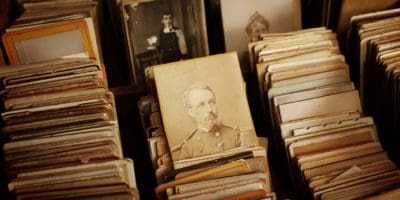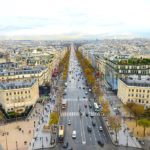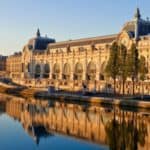15 amazing facts about the Palace of Versailles
Originally Published by Anna in February 2020 and updated by Ruth in August 2022
The Palace of Versailles in an enchanting place where art and nature are perfectly combined. The King Louis XIV is the creator of this unique palace.
Located away from the city of Paris, as if he wanted to protect the monarchy from the quivers and the conspiracies of the capital, the stunning palace is a symbol of power. Louis XIV gathered around him the most important figures of the kingdom. Princes, courtiers and ministers lived in Versailles with him. Everything about the palace is one-of-a-kind.
From the rooms to the gardens, every tiny detail has been thoughtfully chosen and created so that the palace could achieve its glorious look. Order, balance and symmetry are the best words to describe it.
In this article, I will introduce you to one of the most sublime palaces in the world, sharing with you 15 amazing facts about the Palace of Versailles!
What is Versailles?
Being the home to the Kings of France between 1662 and 1789, the Palace of Versailles is one of the most important landmarks in French history. It is also rated as an UNESCO World Heritage. Started as being a simple and modest hunting accomodation until Louis XIV was nominated King and decided Versailles would be a potential place to build a palace.
King Louis XIV transformed this luxurious palace in what we know today, recreating in the form of architecture and art, the biggest and most beautiful palace ever built. The construction of the palace was a representation of his great wealth and power.
Versailles resisted until the French Revolution (1789 – 1799), being not only famous for its strategic place but also as a symbol of the absolute Monarchy system.
In 1837, after the French Revolution, Versailles became a museum. In 1919, a very important milestone in history also happened in the Palace of Versailles, which was the Treaty of Versailles, putting an end to World War One.
Fact nº1: The King first lived in the Louvre
The King Louis XIV used to live in the Louvre, but since it is located right in the center of Paris, surrounded by buildings, it didn’t allow him to enlarge his residence. The King couldn’t show his elegance and the greatness of monarchy, so he wanted something bigger that would express his grandeur. In 1678, Louis XIV left the Louvre for Versailles. That’s when one of the greatest architectural masterpieces Europe has ever known began.
Fact nº2: The Palace was a hunting lodge
The father of the Sun-King, Louis XIII, had a hunting lodge in Versailles. The history of the Palace started in 1623, when Louis XIII bought a piece of land in Versailles to build a hunting lodge, which was very little for someone who knows the customs of the Royal House of France. The first modifications of the Palace only started forty years later, under the command of the king Louis XIV!
Fact nº3: The Grand Canal was a stinking swamp
The land on which the King wanted to build his impressive palace was not fit for the construction. For the project to happen, there was a need of restructuring the whole area.
Earthwork and levelling were essential for the construction to begin. Louis XIII’s hunting lodge was situated on a narrow plateau with many swamps around it. The workers had to fill the area around the plateau with soil and stones, and they also had to dry the swamps up. Nothing was charming about the place before Louis XIV’s great project!
Fact nº4: The water supply was no piece of cake
Versailles was one of the few castles in France that wasn’t located near a river. For a King that wanted hundreds of fountains to be set up, this was a big issue. For his dream to come true, artificials ponds were created. They built aerial and underground aqueducts to supply water for the Palace. All the surrounding waters were redirected to it.
But it was not enough. So, for the Kings promenade in the gardens, they would only activate the fountains at the presence of the King during his walks. As he walked, the fountains would be activated and the previous ones would be deactivated. That’s how they gave the illusion everything was working as expected.
But for the fountains to properly work, more water was needed. They had to pump the water out of the Seine river. This exploit was extraordinary for the time. They had to invent new techniques and hydraulic methods. A revolutionary machine had to be built for this project. Pumps draw water for the Seine river and drove it through pipes more than one hundred meters above the Seine level, for it to reach the aqueducts that would lead the water to the Palace.
Fact nº5: There was a dress code to visit the gardens
The Palace was not restricted only for the King and his court. Everyone could freely visit the Palace and walk its gardens. Nonetheless, there was one condition: you needed to be well-dressed. If you did not have a proper outfit, you could rent one at the entrance of the Palace. Elegance was essential in the Palace of Versailles. Whoever did not follow these rules was not allowed to walk the Palace.
Fact nº6: Everything the King did was a ceremony
The life of the King Louis XIV was exposed for everyone to see. At 10 pm, the King used to have dinner, surrounded by courtiers and valets that assist the “Grand Couvert“, as you can see in the picture above. The “public” is placed according to their social class.
In the morning, the courtiers wait in the antechamber for the King to wake up. As he wakes up, members of the court come to assist “this ceremony”. It was very important to be present when the King woke up, to hear but also to be seen by the King. Everything the Kind did, even the tiniest details of his routine, was a ceremony worthy to attend to.
Fact nº7: The Palace was to impress
For the King, the Palace of Versailles was the reflection of his power and the image of monarchy, so it was very important that everything looked sublime and mesmerizing.
The Galerie des Glaces is my favorite example of what the King wanted to achieve with this project. He wanted to dazzle the visitors with the mirrors, precious marbles, ornamented gilded bronzes. All the most important figures visited this room, so they could leave with the greatest impression of the King and his amazing tastes.
On the vault, one can see paintings that represent the exploits of the reign. At that time, mirrors were very expensive, but the Galerie des Glaces contains 357 mirrors. This showed everyone the wealth of the King.
Fact nº8: The King hired the best men for the design of the Palace
As you now know, everything about Versailles was extravagant. For the design of the Palace, he employed the best architects of the time: André Le Nôtre for the gardens, Louis Le Vau for the architecture, and Charles Le Brun for the decoration. These men did an amazing work! They satisfied all the desires of the King and made all his dreams come true with the help of the workers.
Fact nº9: Large amounts of materials came to Versailles day after day for its construction
For the construction of the Palace of Versailles, materials that come from all around the country of France were necessary. To illustrate the grandeur of France, workers had to work day and night.
About fifty different marbles were forwarded to Versailles, but this was a real challenge. The slate that was used for the roofs came from Angers, the white stones came from L’Oise, and the marbles came from Campan in the Pyrenees. These had to come by sea and reach the Seine river, because the routes of the time were of poor quality. It took six months for the marbles to get to Versailles. But it didn’t matter for the King because the construction of the Palace, the most beautiful jewel of France, was the priority!
Fact nº10: New technical and scientific solutions emerged for the enormous project
The construction of the Palace of Versailles was a real challenge for the time. It was one of the most innovative and contemporary projects. For a project of this dimension, the workers had to adapt the technical and scientific tools. They had to find solutions for all the obstacles the construction had to face: for instance, the water.
In general, when a new construction was undertook, people used the materials found on site. But, for this Palace, materials had to come from different regions of France. This involved thousands of workers and extraordinary methods.
Fact nº11: The smell of the gardens was so strong, it made visitors ill

Courtyard of the Palace of Versailles in Versailles, France by DiscoA340 – Wikimedia Commons
The gardens of Versailles are some of the largest and most spectacular in the world and contain 372 statues, 55 water features, 600 fountains, and over 20 miles of water pipes. Hundreds of thousands of plants and trees have been continually planted over the years.
While this makes the gardens look amazing, in the 17th century the fragrance from these blooms in Trianon was so overpowering it made guests feel ill and drove them away.
Fact nº12:The Treaty of Versailles was signed in the Hall of Mirrors

This is a photo of the hall of mirrors inside the Palace of Versailles by Michael Shade – Wikimedia Commons
The Hall of Mirrors has played host to plenty of splendor over the years, with the room originally being lit by as many as 20,000 candles to transform it into a “corridor of light” during special occasions. But it has also been a witness to some of the most important moments in history, the most significant being the signing of the Treaty of Versailles.
The Treaty was the most important of the peace treaties that brought World War I to a close, ending the state of war between Germany and the Allied Powers. It was signed on 28 June 1919 in Versailles, exactly 5 years after the assassination of Archduke Franz Ferdinand which directly led to the war beginning.
Fact nº13: The king ate cold meals as the kitchen was so far away from his dining room

Palace of Versailles Hall of Mirrors by Gary Todd – Wikimedia Commons
The palace was large, but a potential oversight from the architect was the distance between the kitchen and the dining rooms. With sometimes over 5,000 people to feed, hundreds of servants were needed to get all those mouths fed.
Unfortunately for the king, the distance from his seat to the kitchen was so far away, that his meals were often served cold. Eventually, in the 18th century, Louis XV had private kitchens built in his private apartments.
Fact nº14: Versailles has housed several Royal Menageries

Aerial view of the Palace of Versailles, France by ToucanWings – Wikimedia Commons
It’s well known that Versailles played host to thousands of people at a time, but the palace equally once housed several menageries full of all kinds of wild animals and birds from all over the world.
One of the original features of the palace was an elaborate menagerie built by architect Louis le Vau. It was the first place to divide animal species into separate and specially adapted enclosures which could be seen from the balcony of the central pavilion of La Ménagerie.
This model and approach was soon adopted throughout Europe, and menageries of this kind were eventually called zoos.
Fact nº15: The palace royal gate was destroyed during the French Revolution

Hallway in the Palace of Versailles in Versailles, France by DiscoA340 – Wikimedia Commons
With all that luxury and opulence kept within the palace, it’s no surprise the people of France ultimately detested Versailles, with many people outside of the palace’s gate poor and starving. Marie-Antoinette’s lavish lifestyle was especially loathed for its extravagance.
During the French Revolution that began in 1789, the French revolutionary government ordered to dismantle the front gate, which was completely covered with gold. In 2008, the gate was recreated and decorated with 100,000 gold leaves.
What to consider when visiting Versailles
If you are traveling to Paris for a short time, I recommend you postpone your trip to the Palace of Versailles for a next time, as it will take more than one day to visit everything.
However if you really want to visit the Palace of Versailles, there are a few things you should take into consideration.
The Palace of Versailles is located only twenty minutes outside of Paris, but you will surely take more than an hour to get there because there’s always a lot of traffic in highways and routes of Paris. Also, traveling early in the morning is the best option, since you will be less likely to get stuck in traffic. So, try to leave at around 6 am.
Consider taking the guided tour of the Palace of Versailles from February to May, as it will not be as crowded as other times of the year. Also, try to avoid visiting this landmark on Tuesdays and during the weekends, as it will most surely be overcrowded, either by tourists and even locals during the weekends, or groups of students on Tuesdays.
I recommend you not to go during the summer. Well, of course if you are spending the summer in Paris, visiting the Palace of Versailles is definitely in your bucket list! But you need to be aware that you will have to wait in queues that can go up to three hours, only to get in!
If you decide to go in this time of the year, I highly suggest you start by visiting the gardens, the fountains and the Grand Canal while the other visitors finish their visit of the Palace. You will be able to enjoy a beautiful walk around the Palace of Versailles in peace.
After lunch, around 2 pm or 3 pm, you should head to the Palace to visit it, as it will be a lot less crowded, making this an efficient way of visiting the Palace of Versailles.
A few articles I suggest you to read, if you’re interested in Versailles and other cities of France:
- From Paris to Versailles: the perfect day trip;
- Things to do in Versailles;
- Top 5 French cities to see (except Paris);
- Trip to the Loire Valley from Paris.
My article about the 10 amazing facts about the Palace of Versailles is now over! I hope you’ve enjoyed reading this article. Feel free to share your own thoughts. If you know any other amazing facts about this incredible place, share in the comments.
Visit Versailles
Visiting Versailles is a great idea if you have some time left in France. Check our page to find all the available options for an incredible time in the most magnificent Palace ever.
See you soon!
Planning a trip to Paris ? Get ready !
These are Amazon’s best-selling travel products that you may need for coming to Paris.
Bookstore
- The best travel book : Rick Steves – Paris 2023 – Learn more here
- Fodor’s Paris 2024 – Learn more here
Travel Gear
- Venture Pal Lightweight Backpack – Learn more here
- Samsonite Winfield 2 28″ Luggage – Learn more here
- Swig Savvy’s Stainless Steel Insulated Water Bottle – Learn more here
Check Amazon’s best-seller list for the most popular travel accessories. We sometimes read this list just to find out what new travel products people are buying.






















